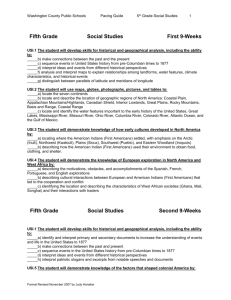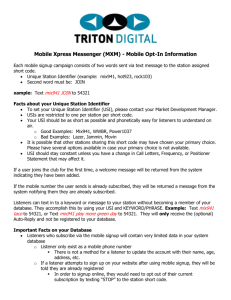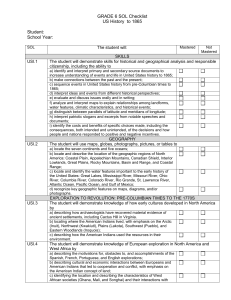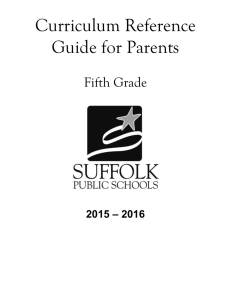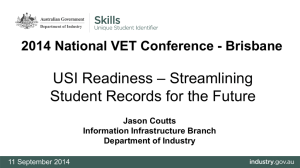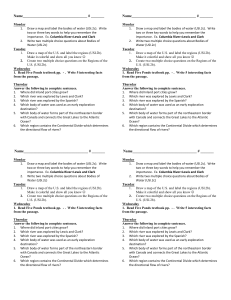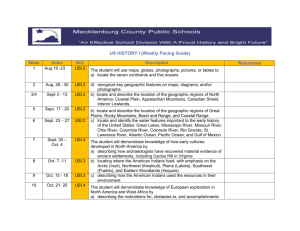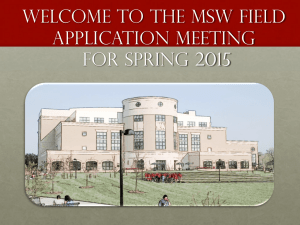United States History to 1877- Expanded Blueprint United States
advertisement
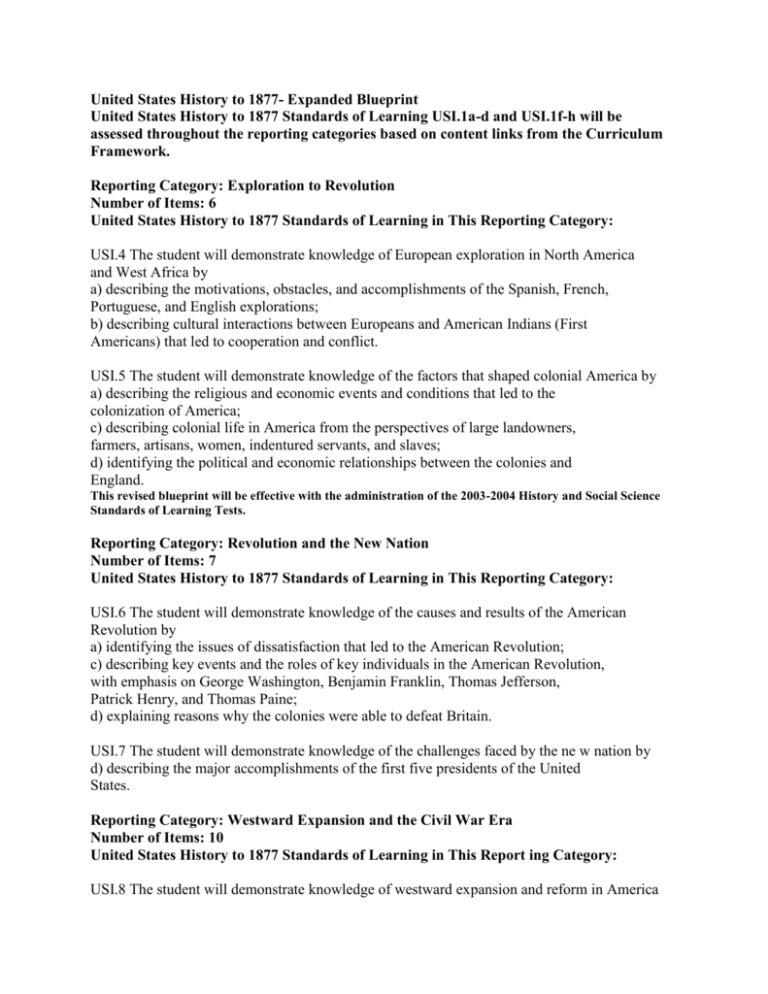
United States History to 1877- Expanded Blueprint United States History to 1877 Standards of Learning USI.1a-d and USI.1f-h will be assessed throughout the reporting categories based on content links from the Curriculum Framework. Reporting Category: Exploration to Revolution Number of Items: 6 United States History to 1877 Standards of Learning in This Reporting Category: USI.4 The student will demonstrate knowledge of European exploration in North America and West Africa by a) describing the motivations, obstacles, and accomplishments of the Spanish, French, Portuguese, and English explorations; b) describing cultural interactions between Europeans and American Indians (First Americans) that led to cooperation and conflict. USI.5 The student will demonstrate knowledge of the factors that shaped colonial America by a) describing the religious and economic events and conditions that led to the colonization of America; c) describing colonial life in America from the perspectives of large landowners, farmers, artisans, women, indentured servants, and slaves; d) identifying the political and economic relationships between the colonies and England. This revised blueprint will be effective with the administration of the 2003-2004 History and Social Science Standards of Learning Tests. Reporting Category: Revolution and the New Nation Number of Items: 7 United States History to 1877 Standards of Learning in This Reporting Category: USI.6 The student will demonstrate knowledge of the causes and results of the American Revolution by a) identifying the issues of dissatisfaction that led to the American Revolution; c) describing key events and the roles of key individuals in the American Revolution, with emphasis on George Washington, Benjamin Franklin, Thomas Jefferson, Patrick Henry, and Thomas Paine; d) explaining reasons why the colonies were able to defeat Britain. USI.7 The student will demonstrate knowledge of the challenges faced by the ne w nation by d) describing the major accomplishments of the first five presidents of the United States. Reporting Category: Westward Expansion and the Civil War Era Number of Items: 10 United States History to 1877 Standards of Learning in This Report ing Category: USI.8 The student will demonstrate knowledge of westward expansion and reform in America from 1801 to 1861 by a) describing territorial expansion and how it affected the political map of the United States, with emphasis on the Louisiana Purchase, the Lewis and Clark expedition, and the acquisitions of Florida, Texas, Oregon, and California; d) identifying the main ideas of the abolitionist and suffrage movements. USI.9 The student will demonstrate knowledge of the causes, major events, and effects of the Civil War by a) describing the cultural, economic, and constitutional issues that divided the nation; b) explaining how the issues of states’ rights and slavery increased sectional tensions; d) describing the roles of Abraham Lincoln, Jefferson Davis, Ulysses S. Grant, Robert E. Lee, Thomas “Stonewall” Jackson, and Frederick Douglass in events leading to and during the war; f) describing the effects of war from the perspectives of Union and Confederate soldiers (including black soldiers), women, and slaves. USI.10 The student will demonstrate knowledge of the effects of Reconstruction on American life by b) describing the impact of Reconstruction policies on the South. This revised blueprint will be effective with the administration of the 2003-2004 History and Social Science Standards of Learning Tests. Reporting Category: Geography Number of Items: 8 United States History to 1877 Standards of Learning USI.2 The student will use maps, globes, photographs, pictures, and tables to a) locate the seven continents; b) locate and describe the location of the geographic regions of North America: Coastal Plain, Appalachian Mountains, Canadian Shield, Interior Lowlands, Great Plains, Rocky Mountains, Basin and Range, and Coastal Range; c) locate and identify the water features important to the early history of the United States: Great Lakes, Mississippi River, Missouri River, Ohio River, Columbia River, Colorado River, Rio Grande, Atlantic Ocean, Pacific Ocean, and Gulf of Mexico. USI.3 The student will demonstrate knowledge of how early cultures developed in North America by a) locating where the American Indians (First Americans) settled, with emphasis on Arctic (Inuit), Northwest (Kwakiutl), Plains (Sioux), Southwest (Pueblo), and Eastern Woodland (Iroquois); b) describing how the American Indians (First Americans) used their environment to obtain food, clothing, and shelter. USI.5 The student will demonstrate knowledge of the factors that shaped colonial America by b) comparing and contrasting life in the New England, Mid-Atlantic, and Southern colonies, with emphasis on how people interacted with their environment. USI.9 The student will demonstrate knowledge of the causes, major events, and effects of the Civil War by c) identifying on a map the states that seceded from the Union and those that remained in the Union; e) using maps to explain critical developments in the war, including major battles. This revised blueprint will be effective with the administration of the 2003-2004 History and Social Science Standards of Learning Tests. Reporting Category: Civics and Economics Number of Items: 9 United States History to 1877 Standards of Learning USI.4 The student will demonstrate knowledge of European exploration in North America and West Africa by c) identifying the location and describing the characteristics of West African societies (Ghana, Mali, and Songhai) and their interactions with traders. USI.6 The student will demonstrate knowledge of the causes and results of the American Revolution by b) identifying how political ideas shaped the revolutionary movement in America and led to the Declaration of Independence, with emphasis on the ideas of John Locke. USI.7 The student will demonstrate knowledge of the challenges faced by the new nation by a) identifying the weaknesses of the government established by the Articles of Confederation; b) identifying the basic principles of the new government established by the Constitution of the United States and the Bill of Rights; c) identifying the conflicts that resulted in the emergence of two political parties. USI.8 The student will demonstrate knowledge of westward expansion and reform in America from 1801 to 1861 by b) identifying the geographic and economic factors that influenced the westward movement of settlers; c) describing the impact of inventions, including the cotton gin, the reaper, the steamboat, and the steam locomotive, on life in America. USI.10 The student will demonstrate knowledge of the effects of Reconstruction on American life by a) identifying the provisions of the 13th, 14th, and 15th Amendments to the Constitution of the United States and their impact on the expansion of freedom in America. This revised blueprint will be effective with the administration of the 2003-2004 History and Social Science Standards of Learning Tests. United States History to 1877 Standards of Learning Excluded from This Test: USI.1 The student will develop skills for historical and geographical analysis, including the ability to e) evaluate and discuss issues orally and in writing.

